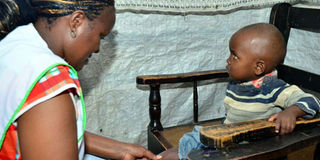Volunteers can help ease pressure on ailing health sector

A Community Health Worker examines a two-year-old in Korogocho Slums, Nairobi. Community workers can plug the shortage of health workers in Kenya. PHOTO| FILE
This has been a tough year for the health sector in Kenya. For about 250 days, public health workers have not functioned as a complete unit due to strikes.
First was the 100-day doctor’s strike, followed by the 151-day nurses’ strike that was called off last Thursday. Clinical officers had also threatened to go on strike as had medical laboratory officers.
Strikes aside, Kenya has an acute shortage of health workers. The 2017 Kenya Health Workforce Status Report puts the ratio of health workers at one per 725 people, far below the WHO recommended ratio of one to 225.
The most vulnerable populations are those who dwell in the rural areas and in informal settlements, where high poverty levels and geographic distances from healthcare facilities perpetuate a vicious cycle.
Many child deaths occur at home, largely from preventable or easily curable diseases such as malaria, acute respiratory infections, pneumonia, diarrhoea and malnutrition.
While universal health coverage is recognised as one of the best ways of achieving the Sustainable Development Goals targets for health, shortage of health workers remains a stumbling block. An effective community-based approach can mitigate this, while alleviating pressure on higher level health facilities.
Community Health Volunteers (CHVs) live in the communities they serve and have rich social networks that they leverage to disseminate information on health. They visit families in the convenience and privacy of their homes, where they check children’s health, support pregnant mothers, and advise parents on better health practices.
The familiarity makes them trusted advisors to their neighbours. Families know they can call them at any time when in need, and the CHV will provide accurate diagnosis and treatment of minor ailments and referrals to health facilities when needed.
In malaria endemic zones such as Busia, CHVs have been used to great effect in dealing with malaria infections. So far in 2017, more than 20,000 malaria tests and treatments have been done by CHVs in the county.
Though public health facilities offer ‘free’ services, families usually pay for transport to the facilities. They also spend time traveling and waiting in queues, which to most folk translates into lost income. Delivering healthcare directly to a family’s home saves precious time and money. It is also a lot easier and more convenient – which they really like.
CHVs are essential in responding rapidly to health crises, delivering routine care, and providing linkages to the health system, which yields life-saving results. However, CHVs are often unpaid— largely relying on implementing partners and donors. As a result, they split their time between community health work and eking out a living, resulting in high attrition rates.
In order to ease pressure on health facilities, counties should prioritise community health by providing medicines and supplies, basic tools, financial and non-financial incentives, training, programme support and supervision of community health volunteers.
With proper support, community health will improve patient outcomes, reduce costs to health systems and patients as well as mitigate effects of health worker strikes and shortages and the effects of disease on households.
Ms Jarman is the Country Director Living Goods – Kenya, a social enterprise focused on improving community health


